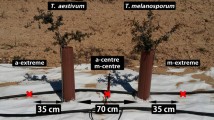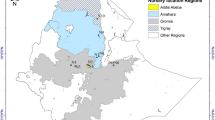Abstract
The cultivation of Tuber melanosporum Vittad., the black truffle, recently expanded all over the world. For successful truffle production, an important factor to consider is the mycorrhization level of the planted mycorrhized-seedlings. To assess the mycorrhization level of a truffle orchard it is necessary to develop a sampling strategy. Root sampling is time-consuming and a delicate operation because it is easy to disturb the ectomycorrhizal communities of the truffle-plants. A standardized and reproducible methodology for sampling mycorrhized roots in truffle orchards has not yet been developed. Consequently, we sampled five T. melanosporum truffle orchards located in Central Italy to determine: (1) the relationship between the number of sampled plants and the presence of T. melanosporum and other ectomycorrhizal Fungi; (2) the minimum number of trees (MNT) needed to achieve a reliable mycorrhization estimate and the minimum sampling ratio (MSR) as the percentage of MNT over the total number of trees present in the truffle orchard. Using a general linear model, we calculated MNT for T. melanosporum and other Fungi in two sampling campaigns in each truffle orchard. The mean values of the MNT ranged among 12–17 and 17–18, respectively, for T. melanosporum and for other Fungi. According to our findings we suggest that at least a MSR of 12% should be considered to have a fair estimate of the mycorrhization level of a truffle plantation.


Similar content being viewed by others
References
Andrés-Alpuente A, Sánchez S, Martín M, Aguirre ÁJ, Barriuso JJ (2014) Comparative analysis of different methods for evaluating quality of Quercus ilex seedlings inoculated with Tuber melanosporum. Mycorrhiza 24(1):S29–S37
Baciarelli Falini L, Rubini A, Riccioni C, Paolocci F (2006) Morphological and molecular analyses of ectomycorrhizal diversity in a man-made T. melanosporum plantation: description of novel truffle-like morphotypes. Mycorrhiza 16(7):475–484. https://doi.org/10.1007/s00572-006-0066-5
Baciarelli Falini L, Bencivenga M, Donnini D, Di Massimo G (2010) Risultati delle ricerche nelle tartufaie della Regione Umbria. In: Atti 3° Congresso Internazionale di Spoleto sul Tartufo, Comunità Montana Monti Martani, vol 660044625. Serano e Subasio, Spoleto, pp 577–589
Baciarelli Falini L, Benucci GMN, Bencivenga M, Donnini D (2012) Mycorrhization level in truffle plants and presence of concurrent fungi. Acta Mycologica 47(2):169–173
Bencivenga M, Baciarelli Falini L (2012) Manuale di tartuficoltura: esperienze di coltivazione dei tartufi in Umbria. Assessorato Regionale Agricoltura e Foreste, Perugia, Italy. ISBN 978-88-96277-12-6
Bengough AG, Castrignanò A, Pagès L, van Noordwijk M (2000) Sampling strategies, scaling, and statistics. In: Root methods. Springer Science, Berlin, pp 147–173. https://doi.org/10.1007/978-3-662-04188-8_5
Benucci GMN, Raggi L, Albertini E, Grebenc T, Bencivenga M, Falcinelli M, Di Massimo G (2011) Ectomycorrhizal communities in a productive Tuber aestivum Vittad. Orchard: composition, host influence and species replacement. FEMS Microbiol Ecol 76(1):170–184. https://doi.org/10.1111/j.1574-6941.2010.01039.x
Benucci GMN, Bonito G, Baciarelli Falini L, Bencivenga M, Donnini D (2012a) Truffles, timber, food, and fuel: sustainable approaches for multi-cropping truffles and economically important plants. Edible ectomycorrhizal mushrooms. Soil Biology. Springer, Berlin, pp 265–280
Benucci GMN, Csorbai AG, Baciarelli Falini L, Bencivenga M, Di Massimo G, Donnini D (2012b) Mycorrhization of Quercus robur L., Quercus cerris L. and Corylus avellana L. seedlings with Tuber macrosporum Vittad. Mycorrhiza 22(8):639–646
Berhongaray G, King JS, Janssens IA, Ceulemans R (2012) An optimized fine root sampling methodology balancing accuracy and time investment. Plant Soil 366(1–2):351–361. https://doi.org/10.1007/s11104-012-1438-6
Cavender-Bares J, Izzo A, Robinson R, Lovelock CE (2009) Changes in ectomycorrhizal community structure on two containerized oak hosts across an experimental hydrologic gradient. Mycorrhiza 19(3):133–142. https://doi.org/10.1007/s00572-008-0220-3
De La Varga H, Le Tacon F, Lagoguet M, Todesco F, Varga T, Miquel I, Barry-Etienne D, Robin C, Halkett F, Martin F, Murat C (2017) Five years investigation of female and male genotypes in Périgord black truffle (Tuber melanosporum Vittad.) revealed contrasted reproduction strategies. Environ Microbiol 19(7):2604–2615. https://doi.org/10.1111/1462-2920.13735
De Miguel AM, Águeda B, Sánchez S, Parladé J (2014) Ectomycorrhizal fungus diversity and community structure with natural and cultivated truffle hosts: applying lessons learned to future truffle culture. Mycorrhiza 24(1):5–18. https://doi.org/10.1007/s00572-013-0554-3
Dickie IA, Xu B, Koide RT (2002) Vertical niche differentiation of ectomycorrhizal hyphae in soil as shown by T-RFLP analysis. New Phytol 156(3):527–535. https://doi.org/10.1046/j.1469-8137.2002.00535.x
Donnini D, Gargano ML, Perini C, Savino E, Murat C, Di Piazza S, Bencivenga M (2013) Wild and cultivated mushrooms as a model of sustainable development. Plant Biosyst 147(1):226–236. https://doi.org/10.1080/11263504.2012.754386
Donnini D, Benucci GMN, Bencivenga M, Baciarelli Falini L (2014) Quality assessment of truffle-inoculated seedlings in Italy: proposing revised parameters for certification. For Syst 2:385–393. https://doi.org/10.5424/fs/2014232-05029
Fischer C, Colinas C (1996) Methodology for certification of Quercus ilex seedlings inoculated with Tuber melanosporum for commercial application. In: Proceedings of the 1st International Conference on Mycorrhiza. 4–9 Aug 1996. Berkeley, California, USA
Govi G, Bencivenga M, Pacioni G, Palenzona M, Tocci A, Zambonelli A (1995) Presentazione del metodo di valutazione delle piante micorrizate con funghi del gen. Tuber basato sulla caratterizzazione morfologica delle micorrize. Regioni: Piemonte, Lombardia, Veneto, Emilia Romagna, Marche, Toscana, Umbria, Lazio, Molise, Abruzzo
Hall IR, Brown GT, Zambonelli A (2007) Taming the truffle: the history, lore, and science of the ultimate mushroom. Timber Press, Portland
Hammond R, McCullagh PS (1978) Quantitative techniques in geography. Clarendon Press, UK
Metcalfe D, Meir P, Aragao LEOC, da Costa A, Almeida S, Braga A, Goncalves P, Athaydes J, Malhi Y, Williams M (2008) Sample sizes for estimating key ecosystem characteristics in a tropical terra firme rainforest. For Ecol Manag 255(3):558–566. https://doi.org/10.1016/j.foreco.2007.09.026
Murat C (2015) Forty years of inoculating seedlings with truffle fungi: past and future perspectives. Mycorrhiza 25(1):77–81. https://doi.org/10.1007/s00572-014-0593-4
Olivier J (2000) Progress in the cultivation of truffles. In: van Griensven LJLD (ed) Proceedings of the 15th international congress on the science and cultivation of Edible Fungi, 15–19 May 2000, vols Mushroom science XV, 2. Rotterdam, Netherlands, pp. 937–942
Olivier JM, Savignac JC, Sourzat P (2012) Truffe et trufficulture. Fanlac, Périgueux
Reverchon F, Del Pilar Ortega-Larrocea M, Pérez-Moreno J (2012) Soil factors influencing ectomycorrhizal sporome distribution in neotropical forests dominated by Pinus montezumae, Mexico. Mycoscience 53(3):203–210. https://doi.org/10.1007/s10267-011-0136-1
Reyna DS (2012) Truficultura: Fundamentos y Técnicas. Mundi-Prensa, Madrid
Reyna S, Garcia-Barreda S (2014) Black truffle cultivation: a global reality. For Syst 23(2):317. https://doi.org/10.5424/fs/2014232-04771
Reyna S, Boronat J, Palomar E (2001) Quality control of plants mycorrhized with Tuber melanosporum Vitt. In: Proceedings of the 2nd international conference on edible mycorrhizal mushrooms, vol 3, p 6. Christchurch, New Zealand, 3–6 July 2001. Crop and Food Research
Sánchez S, Ágreda T, Águeda B, Martín M, de Miguel AM, Barriuso J (2014) Persistence and detection of black truffle ectomycorrhizas in plantations: comparison between two field detection methods. Mycorrhiza 24(1):39–46. https://doi.org/10.1007/s00572-014-0560-0
Taschen E, Rousset F, Sauve M, Benoit L, Dubois MP, Richard F, Selosse MA (2016) How the truffle got its mate: insights from genetic structure in spontaneous and planted Mediterranean populations of Tuber melanosporum. Mol Ecol 25(22):5611–5627. https://doi.org/10.1111/mec.13864
Taylor AFS (2002) Fungal diversity in ectomycorrhizal communities: sampling effort and species detection. Diversity and integration in mycorrhizas. Springer, Dordrecht, pp 19–28
Trappe JM (2005) AB Frank and mycorrhizae: the challenge to evolutionary and ecologic theory. Mycorrhiza 15(4):277–281. https://doi.org/10.1007/s00572-004-0330-5
Varese GC, Angelini P, Bencivenga M, Buzzini P, Donnini D, Gargano ML, Maggi O, Pecoraro L, Persiani AM, Savino E, Tigini V, Turchetti B, Vannacci G, Venturella G, Zambonelli A (2011) Ex situ conservation and exploitation of fungi in Italy. Plant Biosyst Int J Deal Aspects Plant Biol 145(4):997–1005
Zambonelli A, Donnini D, Rana GL, Fascetti S, Benucci GMN, Iotti M, Morte A, Khabar L, Bawadekji A, Piattoni F, Compagno R, Venturella G (2014) Hypogeous fungi in Mediterranean maquis, arid and semi-arid forests. Plant Biosyst 148(2):392–401. https://doi.org/10.1080/11263504.2013.877537
Zambonelli A, Iotti M, Murat C (2016) True Truffle (Tuber spp.) in the world: soil ecology, systematics and biochemistry. Springer, Berlin
Zotti M, Persiani AM, Ambrosio E, Vizzini A, Venturella G, Donnini D, Angelini P, Di Piazza S, Pavarino M, Lunghini D, Venanzoni R, Polemis E, Granito VM, Maggi O, Gargano ML, Zervakis GI (2013) Macrofungi as ecosystem resources: conservation versus exploitation. Plant Biosyst 147(1):219–225. https://doi.org/10.1080/11263504.2012.753133
Acknowledgements
We would like to thank the Agricultural section of the Region of Umbria for providing access to the truffle orchards and conduct the study. We are also grateful to Gilberto Bragato for his suggestions that helped to improve the manuscript. Domizia Donnini thanks DSA3 of the University of Perugia for research support. Giorgio Marozzi was supported by a Ph.D. fellowship from the University of Perugia.
Author information
Authors and Affiliations
Corresponding author
Additional information
Publisher's Note
Springer Nature remains neutral with regard to jurisdictional claims in published maps and institutional affiliations.
Electronic supplementary material
Below is the link to the electronic supplementary material.
Rights and permissions
About this article
Cite this article
Baciarelli Falini, L., Marozzi, G., Onofri, A. et al. How many samples do you need to assess mycorrhization in Tuber melanosporum orchards? A methodology for a reliable estimation. Agroforest Syst 94, 517–525 (2020). https://doi.org/10.1007/s10457-019-00421-4
Received:
Accepted:
Published:
Issue Date:
DOI: https://doi.org/10.1007/s10457-019-00421-4




